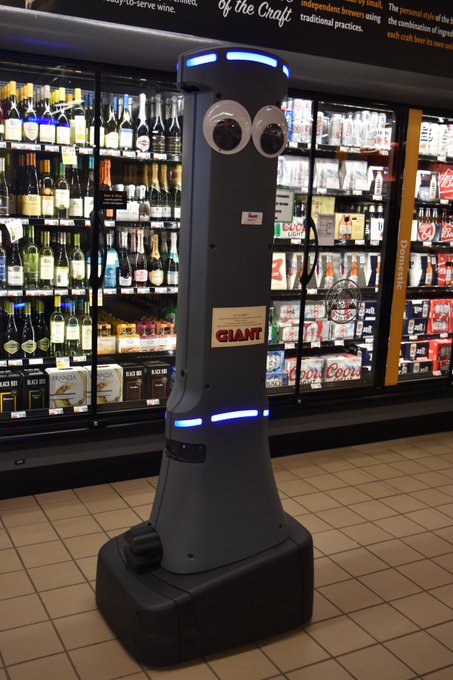By Peter Holley posted January 14th, 2019 on www.washingtonpost.com

(Sue Gleiter/PennLive.com)
He goes by the name “Marty.”
Tall, slow-moving and gray, he has big cartoonish eyes that disguise something unique about the newest employee at Giant Food Stores: Marty is deliberate and relentless, and — unlike his fellow employees — he has the ability to work a seemingly endless number of hours without pay.
Though he doesn’t say much, a small message is always plastered to his slender trunk:
“This store is monitored by Marty for your safety,” it reads. “Marty is an autonomous robot that uses image capturing technology to report spills, debris and other potential hazards to store employees to improve your shopping experience.”
After a pilot program that kicked off in several Pennsylvania stores this past fall, Giant Food Stores announced Monday that it will place Martys in each of the supermarket chain’s 172 stores across Pennsylvania, Maryland, Virginia and West Virginia. The robotic rollout is part of a plan by Giant’s parent company, Ahold Delhaize USA, to deploy about 500 robots to stores such as Giant, Martin’s and Stop & Shop. The robots will begin arriving “in waves” over the coming months, according to Giant, which expects to have the devices fully deployed in about six months.
“Bringing robotics and A.I. from a research lab to the sales floor has been a very exciting journey, and we were thrilled by the customer response in our pilot stores,” Nicholas Bertram, president of Giant Food Stores, said in a statement. “Our associates have worked hard to bring this innovation to life with amazing partners.”
[Walmart’s latest hire: Robotic janitors that clean floors and collect data]
The robots move around the store unassisted, scanning the floors for spills and trip hazards, which are reported to human workers, the company said. Once a spill is located, the machine — which makes beeping noises as it moves — reports it by verbally communicating to human employees after paging them.
Marty says, “caution, hazard detected,” to alert customers, but the machine also sends an announcement through a store’s public address system, alerting associates.
In addition to scanning shelves for items that are out of stock, Marty also does price checks, looking for discrepancies between the shelf and the store’s scanning system, Patrick Maturo, manager of store optimization at Ahold USA, told PennLive.
The news outlet reported that Marty is equipped with scanners to avoid collisions, is powered by rechargeable lithium batteries and has multiple cameras.
Giant said the robots’ efforts free up associates to spend more time serving customers and help reduce the risk caused by spilled foods. Because he is doing assistant work, Maturo said, Marty isn’t replacing human jobs. He said the customer response has been largely positive.
Maturo said people often “just walk right by” the robots. “Then there’s a large majority of people that are very excited to see a robot in the store,” he said.
“They tend to take pictures of it, video of it and selfies with the robot,” he added. “It’s very cool.”
Giant isn’t the only retailer turning to robots to police its many aisles. In December, Walmart announced plans to place 360 autonomous robots inside stores across the country by the end of January.
Their job: scrubbing the store’s expansive aisles and collecting data in the process.
Those robot custodians are powered by Brain Corp, a San Diego-based technology company that has partnered with Walmart. The retailer has a fleet of more than 100 of the devices operating in its stores.
[A new fleet of autonomous robots is now making one of the world’s oldest foods]
Automation will allow workers to perform new tasks in some industries, but it won’t stop millions of people from needing to switch occupations or upgrade their skills in the coming years, according to a McKinsey Global Institute report released last year.
The report estimates that as many as 800 million people may lose their jobs to robots by 2030. Some of those jobs sound a lot like cleaning floors at Walmart.
“Activities most susceptible to automation include physical ones in predictable environments, such as operating machinery and preparing fast food,” the report states. “Collecting and processing data are two other categories of activities that increasingly can be done better and faster with machines.”



